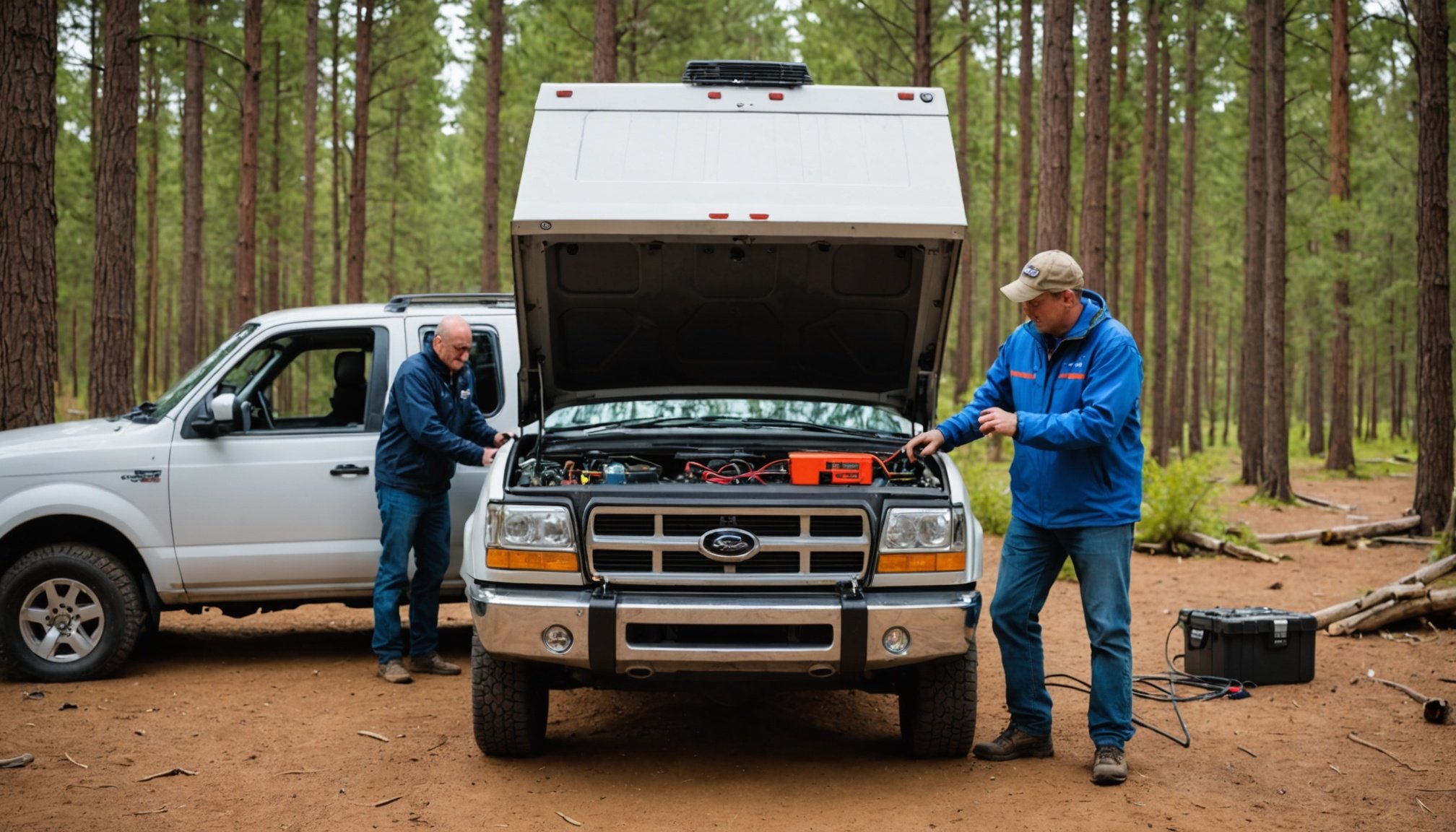Understanding Dual Battery Systems
Dual battery systems are an essential component for camping vehicles, designed to manage power distribution effectively and cater to various power needs. These systems allow users to isolate the starter battery from auxiliary power needs. This separation ensures that primary vehicle power is secured, eliminating the risk of being stranded with a depleted battery.
Camping vehicles often require a diverse range of power needs for activities such as lighting, refrigeration, and charging electronic devices. Dual battery systems provide the necessary output to support these activities without impacting the vehicle’s ability to start. These systems also offer significant convenience, as they enable continuous usage of electronics during extended camping trips.
Also read : Mastering sunroof care: key maintenance tips for peak vehicle performance
Battery management is crucial in ensuring the performance and longevity of a dual battery system. By monitoring charge levels and power usage, users can maintain the health of both batteries. Implementing effective battery management practices helps prevent over-discharge and extends the lifespan of the batteries. Modern dual battery setups often include intelligent battery monitoring systems that automate the balancing and distribution of power, ensuring optimal performance and user convenience.“`
Essential Tools and Materials for Installation
Choosing the right installation tools and components is critical for a successful dual battery setup. Firstly, essential tools include wire cutters, crimping tools, and a multimeter for ensuring accurate electrical connections. These tools help in cutting and connecting multiple wiring materials, facilitating the flow of power between the batteries efficiently.
Also to see : Smart strategies for safeguarding your electronics during vehicle transport
Understanding battery components is also important. Different battery types, such as AGM (Absorbed Glass Mat) and Lithium, come with unique specifications. AGM batteries are often preferred for their durability and maintenance-free nature, while Lithium offers enhanced efficiency but at a higher cost. Selecting the right battery, considering factors like capacity and longevity, boosts performance.
To ensure secure and reliable connections, choose suitable wiring materials such as heavy-duty cables and quality connectors. Importantly, using the right gauge wires minimizes resistance and potential power loss, enhancing the system’s effectiveness. Additional components like battery isolators and fuses provide extra layers of safety by preventing overcharging or discharging issues.
In summary, the right combination of tools, battery components, and wiring materials ensures a safe and efficient installation, catering to the varied power needs of camping vehicles.
Step-by-Step Installation Guide
Installing a dual battery system requires a meticulous approach to ensure efficiency and safety. Begin by securing the necessary installation tools such as wire cutters, crimping tools, and a multimeter. These tools aid in creating precise electrical connections. Next, identify a suitable location within the camping vehicle to mount the auxiliary battery and battery isolator, considering both accessibility and ventilation.
Wiring setup is crucial. Ensure heavy-duty cables are utilised for the main connections between the primary and auxiliary batteries to minimise resistance. Follow precise wiring diagrams and connection points, paying attention to polarity to avoid damaging the system. It’s advisable to install a fuse close to the main battery as a safety measure.
For safety precautions, before beginning the installation, disconnect the vehicle’s battery to prevent any electrical hazards. Always ground the auxiliary battery properly, connecting it to the vehicle’s chassis for stability. Post-installation, double-check all connections to confirm they are secure and free from wear.
Lastly, consider integrating an intelligent battery management system. This provides automated safety installation, distributing power effectively and preventing overcharging. Regular monitoring post-installation sustains the system’s performance.
Troubleshooting Common Issues
Once your dual battery system is installed, encountering issues is not uncommon. Identifying typical problems, such as battery drainage or connectivity issues, is crucial. Check for poor connections frequently, as loose or corroded terminals often lead to inconsistent power supply. Use a multimeter to examine voltage levels to ensure both batteries are charging properly and maintained at the correct voltage.
Solutions and fixing techniques are essential for resolving these issues. Tightening terminals and applying a battery protector sleeve can prevent corrosion. If your auxiliary battery isn’t charging, inspect the isolator; a faulty isolator could be the root cause. Replacing it might resolve charging problems. Additionally, trace the wiring for any damage or wear that might disrupt the flow of power.
Regular checking and monitoring prolongs system reliability. It’s recommended to perform monthly checks, monitoring for abnormal discharges or irregular charging patterns. Keep a record of voltage levels and check charging equipment. Routine maintenance allows early detection of potential issues, mitigating the risk of sudden failures. Empowering yourself with these troubleshooting techniques ensures that your dual battery system remains both efficient and dependable throughout your adventures.
Maintenance Tips for Longevity
Efficient battery maintenance is paramount for maximizing the lifespan of your dual battery system. Regularly inspecting connections, especially after bumpy trails, is a straightforward yet effective preventative measure. Checking for corrosion on terminals and ensuring they are secured tight optimises performance.
Monitoring battery levels is essential. Utilising battery management systems can automate this process, providing real-time data on charge and discharge cycles. This transparency allows for timely interventions when battery levels fall below desired thresholds, thus avoiding over-discharge. Consider investing in a quality multimeter to frequently measure voltage levels.
Optimizing performance involves not just checking but also testing your setup under different loads. This predictive practice helps identify any voltage drops or unexpected power drains. Ensuring batteries are stored fully charged can prevent sulfate buildup, a common issue leading to reduced capacity.
Prioritise seasonal checks, particularly before wintering your vehicle or after seasonal exposure. In these checks, verify that all battery components and connections are intact. Implementing these maintenance strategies will extend the functional lifespan of your battery system, ensuring continued reliability during your camping adventures.
Remember, consistent preventive care is key to sustaining your dual battery system’s performance.
User Testimonials and Expert Opinions
Understanding how a dual battery system significantly enhances camping experiences provides invaluable insights. Users frequently emphasise the reliability and convenience this setup offers, particularly during extended trips. For instance, one camper highlighted running all essential electronics without worrying about draining the starter battery, thanks to a dual setup. By isolating power needs, campers avoid common issues like battery failures.
Experts in vehicle electrification recommend dual battery systems for anyone seriously considering off-grid adventures in their camping vehicles. They underscore the importance of choosing the right components and maintaining efficient power distribution. This ensures not only optimal performance but also dictates the overall longevity and efficiency of the system.
Camping enthusiasts note that proper installation is crucial. Many have cited following detailed guides, which significantly influenced their success and satisfaction. Experts advise conducting regular maintenance to proactively prevent issues, a sentiment echoed by users who have seen improved performance and reliability.
User satisfaction is consistently high for systems managed with smart battery controllers, contributing to an overall smoother camping experience. Enhanced reliability, reduced anxiety over power resources, and enjoying technological conveniences highlight the core benefits celebrated by users and experts alike.











